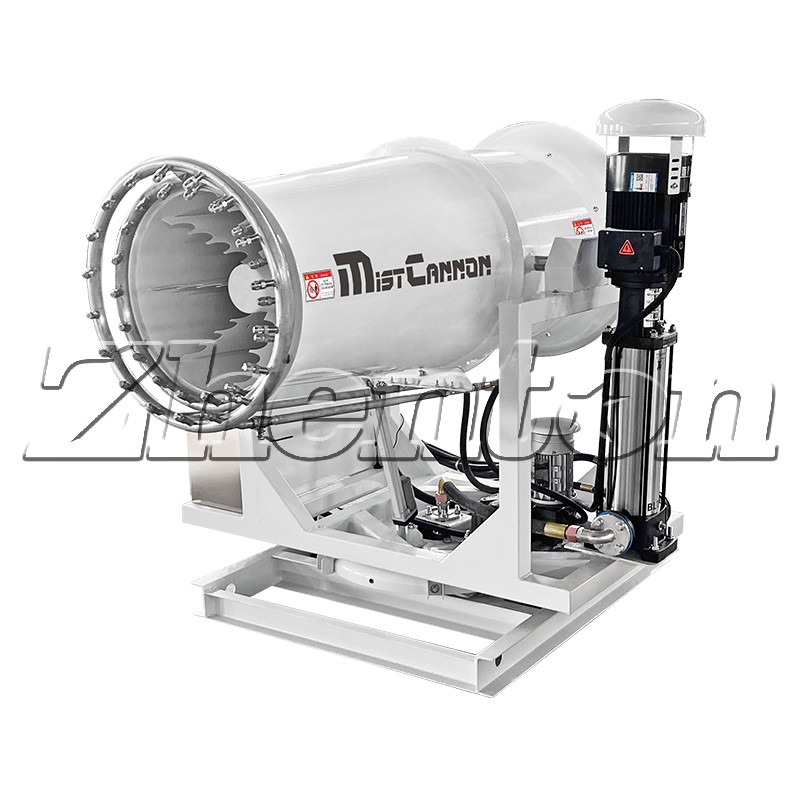
At the end of urban underground pipelines, wastewater treatment plants purify water 24/7 while becoming “odor hotspots.” From the pungent stench in grille rooms to the strong ammonia smell in sludge dewatering workshops, these suffocating odors stain urban air—triggering frequent resident complaints and endangering plant workers. As traditional deodorization methods falter, mist cannon machines pioneer a new path for odor control with disruptive technology.
Wastewater treatment plant odors stem from complex sources: fermenting solids in grilles, microbial decomposition in aeration tanks, and biochemical reactions during sludge disposal—releasing hydrogen sulfide, methanethiol, ammonia, and other malodorous substances. Environmental monitoring shows odor concentrations around untreated plants often exceed standards by 2-3 times, irritating respiratory systems and potentially causing nervous system damage from long-term exposure. Traditional methods like activated carbon adsorption or chemical spraying suffer from saturation failure, high reagent consumption, and costly maintenance—unable to meet the plants’ intense, continuous odor challenges.
Mist cannon machines use ultra-high-pressure gas-liquid mixing to atomize eco-friendly deodorants into 10-50 micron nano-droplets. These droplets diffuse deeply into every corner of wastewater pools and sludge chambers, targeting odor molecules with active surface components. In a sewage plant application, hydrogen sulfide levels in the sludge thickening area dropped from 12ppm to 1.5ppm within 15 minutes of activation, with ammonia concentration decreasing by 82%. The core lies in the droplets’ ability to rapidly neutralize and decompose malodorous substances into harmless gases.
Tailored to wastewater plants’ complex layouts, mist cannon machines establish intelligent coverage systems. Multi-axis rotation allows 360° horizontal/ -10° to +60° vertical adjustment, paired with 20-80m adjustable ranges—enabling precise spraying for open aeration tanks or enclosed sludge fermentation tanks. At an industrial park wastewater plant, a network of mist cannons formed a three-dimensional deodorization matrix, dynamically monitoring and treating 12 core odor sources to eliminate blind spots.
New-generation mist cannons integrate IoT technology, linking real-time with plant odor monitoring systems. When H₂S/ammonia sensors detect exceedances, the system auto-generates optimal deodorization plans: low-frequency pulse spraying during light odor periods, full-power operation during spikes. Managers can remotely adjust parameters via mobile apps or pre-plan strategies based on weather forecasts—e.g., increasing spray volume before heavy rains to suppress odor release from rainfall scouring.

Mist cannon machines deliver more than odor elimination. Environmentally, their biodegradable bio-enzyme deodorants prevent secondary pollution, improving surrounding air quality. Economically, intelligent reagent ratio reduces deodorant use by 40% and energy consumption by 35%. A municipal wastewater plant saw 90% fewer odor complaints and 65% lower occupational disease rates post-adoption—achieving a win-win for ecological and human welfare.

In the era of urban environmental refinement, mist cannon machines reshape wastewater plants’ fresh air ecology through technology. More than innovative odor control equipment, they symbolize urban green development—allowing wastewater treatment plants to purify water while serving as “invisible guardians” of city air.
Contact With Us
If you have any questions please fell free to contact with us.